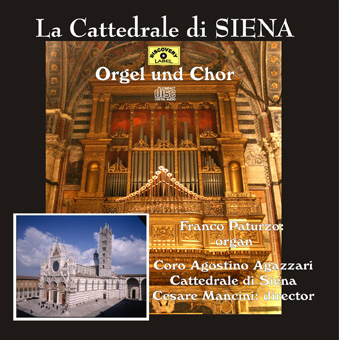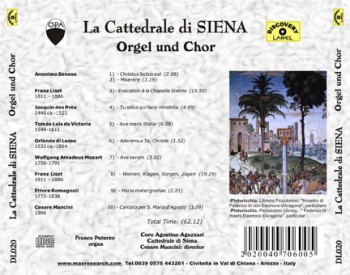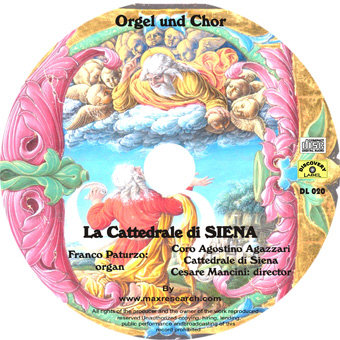La Cattedrale di Siena – Orgel un Chor (DL020)
Title: La Cattedrale di Siena – Orgel un Chor
Performer:
Organ: Franco Paturzo
Coro Agostino Agazzari – Cattedrale di Siena
Director: Cesare Mancini
La Cattedrale di Siena

| ||
|---|---|---|
Tracklist:
Anonimo Senese - 1) – Christus factus est
sec. XVIII 2) – Miserere
Franz Liszt - 3) – Evocation à la Chapella Sixtine
1811 – 1886
Josquin des Près – 4) – Tu solus qui facis mirabilia
1440 ca.-1521
Tomás Luís de Victoria – 5) – Ave maris Stella
Orlando di Lasso – 6) – Adoramus Te, Christe
1532 ca.-1594
Wolfgang Amadeus Mozart – 7) – Ave verum
1756-1791
Franz Liszt – 8) – Weinen, Klagen, Soegen, Zagen
1811 – 1886
Ettore Romagnoli – 9) – Maria mater gratiae
1772-1838
Cesare Mancini - 10) – Cantata per S. Maria d’Agosto
Brevi note sulla registrazione
In prima incisione assoluta vengono qui presentati due brani eseguiti in antico nella Cattedrale senese, entrambi nella Domenica delle Palme. La loro paternità è incerta; l’unica fonte è una trascrizione risalente alla fine del secolo XVIII. Il Christus, dalla scrittura polifonica più elaborata e più articolata, evidenzia un’alternanza tra sezioni omofoniche e sezioni imitative ed esprime il dolore della Crocifissione contenuto nel testo tramite un accorto trattamento delle dissonanze.
Il Miserere è invece nella caratteristica forma del falsobordone, retaggio di una pratica diffusa soprattutto nel Cinque-Seicento nelle grandi Cattedrali.
In prima incisione assoluta è anche il piccolo mottetto del senese Ettore Romagnoli basato su uno dei testi mariani più popolari delle tradizioni della Civitas Virginis, il Maria mater gratiae. Romagnoli, celebre storico dell’arte, scrittore e studioso di storia patria, fu anche maestro di cappella della chiesa di Provenzano, ma in gioventù aveva studiato presso l’allora fiorente scuola di musica annessa alla Cattedrale.
Josquin des Près è uno dei maggiori compositori del Quattrocento. Nato nell’attuale Francia del Nord, in Piccardia, si formò secondo quelle solide basi contrappuntistiche che fecero grande la cosiddetta scuola fiamminga. Come altri musicisti della sua epoca, viaggiò molto, soprattutto in Italia, già allora paese di riferimento per la produzione culturale, grazie al mecenatismo favorito dal sistema delle signorie: Milano, Ferrara, Roma, Parigi furono le sue tappe principali prima che si ritirasse a Condé sur l’Escaut, ove visse gli ultimi anni come canonico. Il mottetto Tu solus qui facis mirabilia può essere riferito al periodo milanese, poiché riflette, nella sua omofonia e nel suo ascolto di immediata comprensione del testo, lo stile tipico della cappella sotto gli Sforza. Fu pubblicato nel 1503 da Ottaviano Petrucci.
Assieme a Palestrina e Orlando di Lasso, de Victoria è uno dei principali polifonisti del Cinquecento. Dalla natia Spagna si spostò a Roma, dove completò la propria formazione e dove per qualche tempo si impegnò come maestro di cappella. Uomo di profonda fede, ha lasciato unicamente composizioni sacre. Tra queste, il mottetto Ave maris stella si distingue per la sua struttura, che prevede un’esecuzione in alternatim tra strofe tratte direttamente dall’inno gregoriano e strofe polifoniche scritte con un meraviglioso contrappunto imitativo della stessa melodia gregoriana.
Similmente a Josquin des Près, Orlando di Lasso, nato nell’attuale Belgio, viaggiò in molte parti d’Europa, soprattutto in Italia, Francia e Germania, assimilando gli stili dei vari paesi con una maestria evidente in particolare nella produzione profana. Tuttavia, anche la produzione sacra, benché sostanzialmente estranea a tradizioni regionali, mostra una multiformità di stili che esaurisce le possibilità compositive dell’epoca.
L’Adoramus Te, Christe, destinato alla Settimana di Passione, è condotto su una generale omofonia che non esclude sottili e raffinati inserti imitativi.
A fronte di una produzione imponente che spazia da monumentali Messe a Vespri a brani di varia destinazione liturgica, la più celebre composizione sacra di Mozart è sicuramente il mottetto Ave verum. La ragione non va tanto ricercata nelle sue contenute proporzioni che favoriscono una grande diffusione di esecuzioni, quanto nella sublimità dell’ispirazione che nulla toglie al felice impatto dell’ascolto immediato. Appartenente alle ultime composizioni della vita del musicista, fu scritto per la festa del Corpus Domini del 1791 a Baden. La sua struttura rivela un perfetto connubio tra stile di Lied tedesco e stile mottettistico italiano.
Uno degli aspetti più considerevoli dell’arte di Bach è il trattamento da egli riservato al corale (in tedesco Kirchenlied), ossia al canto tipico del culto protestante. Oltre a numerosissime armonizzazioni per coro, spesso inserite nelle Cantate e nelle Passioni, il grande musicista tedesco ha lasciato oltre cento elaborazioni delle melodie per organo, i cosiddetti preludi-corali. Questi brani venivano di solito affiancati al corrispondente canto corale durante il culto, in modo da commentare, anche da un punto di vista teologico, il contenuto della musica e del testo. E questa versione originale, di affiancamento di parti corale e strumentale, si propone nel presente disco il celebre Wachet auf, riservato ai periodi d’Avvento, la cui elaborazione per organo è una trascrizione effettuata dallo stesso Bach di un brano della Cantata 140.
La festa dell’Assunta, celebrata il 15 agosto, è da sempre una delle più sentite e partecipate dei Senesi; naturalmente è la festa della Cattedrale, a lei dedicata. La Cantata a S. Maria d’agosto, concepita proprio per questa ricorrenza ed eseguita per la prima volta nel 2005, si configura quindi come un esempio di produzione contemporanea che si inserisce nella tradizione dei canti popolari sacri di Siena
Buon ascolto
Massimo Piantini
Brief notes on the recording
In first absolute recording are here presented two pieces performed formerly in the Cathedral of Siena, both on the Sunday of the Palms. Their paternity is not certain; the only source is a trascription dated back to the end of the XVIII century. The Christus, which has a more elaborate and articolate polifonic writing, point out an alternation of homophonic and imitative sections and express the grief of Crocifission contained in the text thanks to an accurate tratment of the dissonances.
The Miserere, instead, is presented in the characteristic form of farbuden, heritage of a common practice mostly in the Sixteenth-Seventeenth century in big Cathedrals.
In first absolute recording is also the small motet of Ettore Romagnoli, based on one of the most popular Marian texts in the Civitas Virgin tradition, that is to say the Maria Mater Gratiae.
Romagnoli, famous art historian, writer and studious of Italian history,was also master of chapel in the church of Provenzano, but in his youth he had astudied at the flourishing music school belonging to the Cathedral.
Josquin des Près is one of the greater composer of the Fifteenth century. Born in the present Northern France, in Piccardia, he studied in accordance with those contrapuntal solid basis which made big the so called flemish school. As other musicians of his time, he travelled a lot, especially in Italy, even then country of reference for cultural production, thanks to the mecenatism favoured by the system of Signorie: Milan, Ferrara, Rome, Paris, were his principal stages before he retired to Condè sur l’Escaut, where he lived his last years as a canonic. The motet Tu Solus Qui Facis Mirabilia can be referred to the milanese period, because it reflects, in its homophony and its hearing of immediate comprehension of the text, the typical style of the Chapel in the time of the Sforzas. Was published in 1503 by Ottaviano Petrucci.
Together with Palestrina and Orlando di Lasso, de Victoria is one of the main polyphonist of the Fifteenth century. From the native Spain he moved to Rome, where he completed his formation and where for some time he worked as master of chapel. Man of profound faith, he left only sacred composition. Among these, the motet Ave Maris Stella stands out because of its structure which provides an execution in alternatim between stanzas drawed directly from the Gregorian Himn and polyphonic stanzas written with a wonderful counterpoint imitative of the same gregorian melody.
Similarly to Josquin des Près, Orlando di Lasso, born in the present Belgium, travelled in many parts of Europe, especially in Italy, France and Germany, assimilating the styles of the vary countries with an evident ability, particualrly in the profane production. Anyway the sacred production as well, although basically unrelated to regional traditions, shows a multiformity of styles that exhausts the compositive possibilities of the epoch. The Adoramus Te, Christe, destined to the Week of the Passion, is conducted on a general homophony that does not exclude thin and refined imitative inserts.
In connection with a huge production that ranges from the monumental Messe a Vespri to pieces of vary liturgic destination, the most famous sacred composition of Mozart is surely the motet Ave Verum. The reason is not to be searched in its moderate proportions which favour a great diffusion of executions, but in the sublimity of the inspiration that nothing takes from the happy impact of the immediate hearing. Belonging to the last compositions in the life of the musician, was written for the Corpus Domini Feast of the 1791 in Baden. Its structure reveals a perfect union between the Lied german style and the motet italian style.
One of the most considerable aspescts of the art of Bach is the treatment he reserves to the Choral (in german Kirchenlied), that is to say the tipical singing of the protestant cult.
Further a large number of harmonizations for chorus, often inserted in the Cantate and the Passioni, the great german musician have left more than hundred elaborations of the melodies for organ, the so called choral-preludes. These pieces were generally supported by the correspondent choral singing during the cult, so that they commented, also by a teologic point of view, the content of music and text. This original version of supporting choral and instrumental parts, is proposed in the herein disc the famous Wachet Auf, reserved to the periods of the Advent, which elaboration for organ is a trascription effected by Bach himself of a piece of the Cantata 140.
The Assunta Feast, celebrated on the 15th of August, is traditionally one of the most felt and participated by people in Siena; obviously is the feast of the Cathedral, dedicated to Her.
The Cantata to Saint Mary of August, conceived specially for this recurrence and performed the first time in 2005, takes shape as an example of contemporary production which is inserted in the tradition of popular sacred singing of Siena.
Enjoy the concert
Massimo Piantini
Per info o acquisto / For info or to buyEmail: maxre@maxresearch.comSull’email indicare nome e codice prodotto, e il motivo del contatto.GrazieOn email indicating name and product code, and a contact reason.Thank youDownload sample audio HD 24bit 96KHZ Max Research productionDownload sample audio Max Research production | ||
|---|---|---|
| ||||||||||||||
|---|---|---|---|---|---|---|---|---|---|---|---|---|---|---|




 D5 Creation
D5 Creation